 Tarun Kumar Reddy Atmakuru |
Tarun Kumar Reddy Atmakuru |
 Nov 7, 2025
Nov 7, 2025
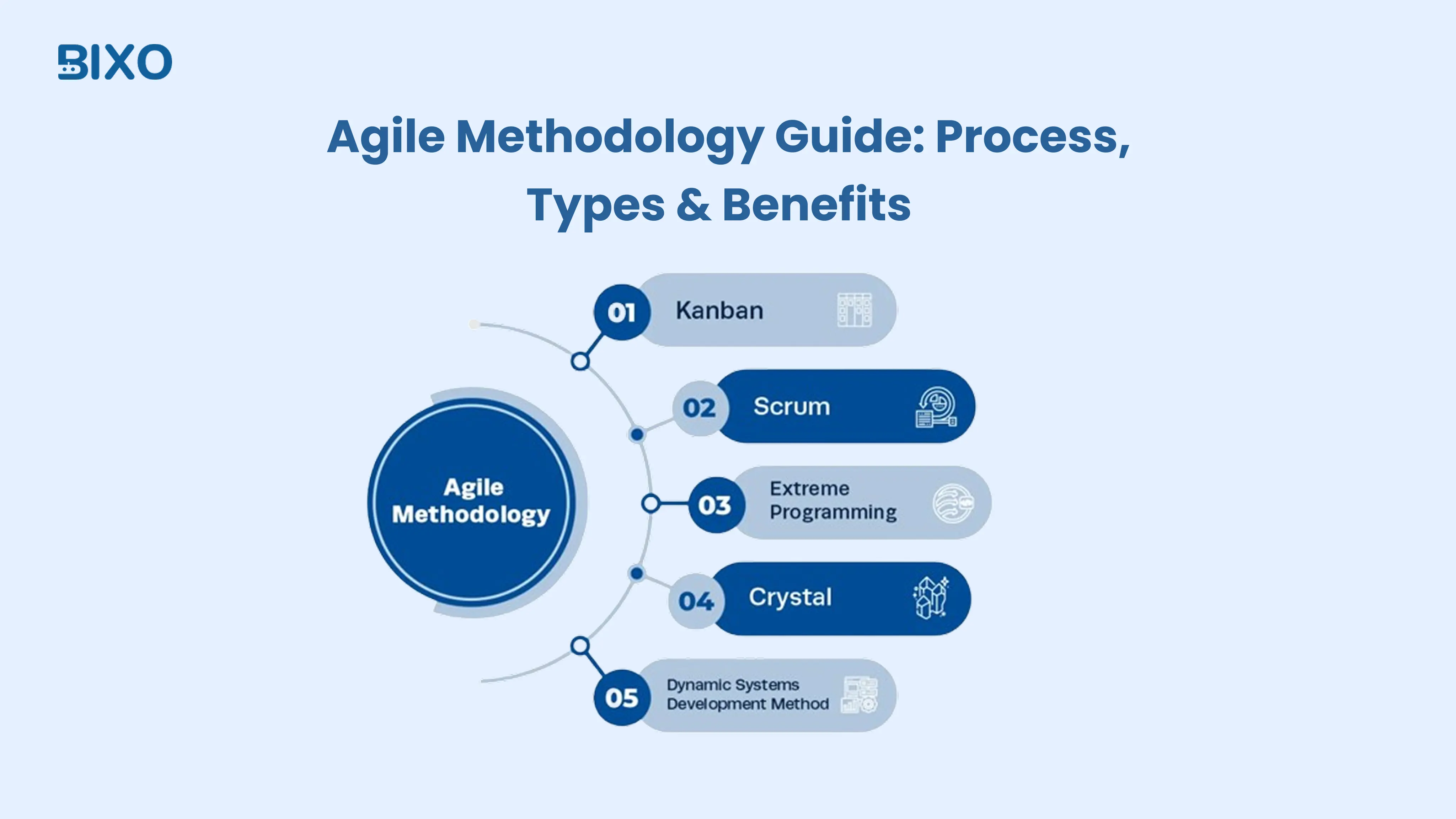
Table of Content
Focus on what matters. BIXO handles the rest!

Getting a project done on time with the exact outcome you want is tough. Plans shift. Needs evolve. People change direction halfway through. That is where agile methodology comes in. It keeps the work flexible so you can adapt as things change, while still staying organised and in control of the final result.
If you work on products or software, you already know the pressure. Faster releases. Better results. No excuses. Agile approach helps you turn big plans into smaller steps that actually get done. You stay close to what users really want. You learn as you go. You catch issues early before they drain time and money. The team stays on track, knows what matters, and feels good about the progress.
This guide walks you through how agile really works. You will learn the key steps, the different styles you can choose, and the situations where agile makes the most sense. You will also see why so many teams trust it to stay flexible, deliver faster, and adapt to changes without chaos. Agile also has a few challenges, and you’ll learn how the right tools can help you manage them and make your projects run smoother and smarter.
What Is Agile Project Methodology?
Agile project methodology helps you manage work in a flexible and realistic way. You take a big project, break it into smaller tasks, and move forward in short cycles. Each cycle delivers something useful that you can test, review, and improve with real feedback.
If priorities change, you adapt without losing momentum. This approach keeps everyone focused on what people truly need, strengthens teamwork, and helps you deliver better results faster than traditional planning methods.
What Are the Key Steps in the Agile Methodology Process?
Agile works best when you stick to a steady rhythm. Each step moves you forward with clarity while keeping you flexible enough to handle change.
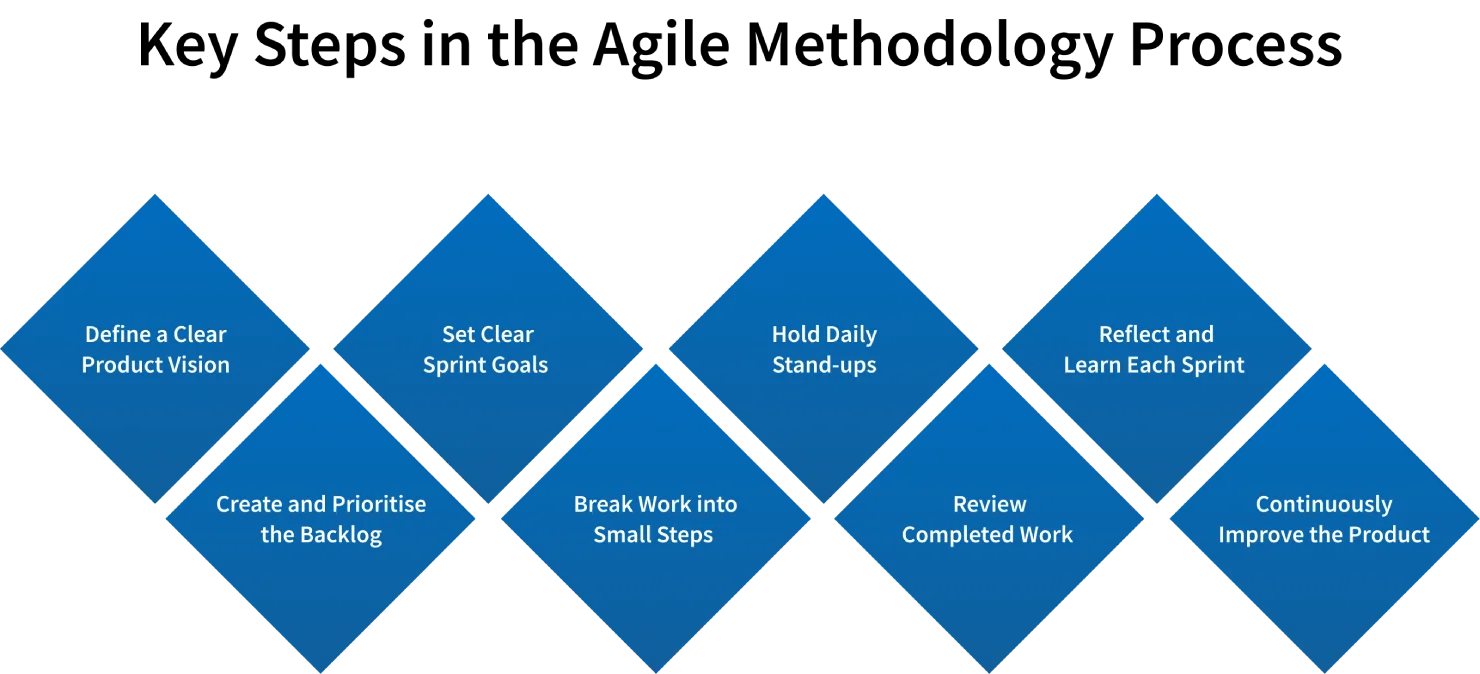
Start with a Clear Product Vision
You always begin by knowing why the project exists. What problem are you solving? Who actually needs it? You do not need pages of technical detail at this stage. You just need a simple, strong direction that everyone can trust. When everyone knows exactly why the project exists and what success looks like, everything flows better.
People make smarter decisions. If plans change, the team shifts direction without losing focus. A strong vision keeps the agile process focused on real value, not distractions.
Build and Prioritise a Product Backlog
After you have a clear vision, make a list of all the features, tasks, and improvements your product might need. This list is called the product backlog. Put the most important items at the top so the team works on what matters first. Keep updating the list as you learn more. This step is important in agile because it prevents wasted effort and keeps the team focused on the right things.
Plan the Sprint Goals Clearly
In the sprint planning meeting, you decide what work your team can realistically finish in a short period, usually 2 to 4 weeks. You set the goals for the sprint, list the tasks, and decide how to measure success. This makes it clear what everyone should do next, helps the team stay productive, and keeps the work organised and manageable.
Work on Tasks in Small Steps
During a sprint, you work on the product in small steps. You design, build, test, and tweak as you go. Because each cycle is short, you can find the problems as soon as possible, improve quality faster, and avoid big mistakes later. Instead of waiting months to see results, you make steady progress all the time.
Hold Daily Stand-Up Meetings
A short daily meeting keeps everyone on the same page. You talk about what you did yesterday, what you will do today, and any problems in your way. This assists you in fixing the problems quickly before they grow. Regular communication like this is a main part of agile work.
Review What the Team Completed
When a sprint ends, you walk everyone through what the team actually finished. Stakeholders look at it, share their thoughts, and point out anything that needs to shift. If the feedback changes your priorities, you update the backlog and adjust the next sprint. This simple review keeps the product grounded in what people truly need, not in assumptions. It is how agile stays focused, flexible, and always improving.
Reflect on the Sprint and Learn
Here’s the thing. When a sprint ends, you do not just rush into the next one. You take a moment to talk. What worked well. What got in the way? What you wish had gone differently. These honest conversations help you spot simple changes that make the next sprint smoother. Over time, this builds a team that keeps improving. Agile is not only about delivering features faster. It’s about getting better together after every sprint.
Improve the Product Continuously
You launch real, working features early instead of waiting for a big final release. Once people start using them, you learn what works and what does not. Then you make changes, improve the product, and release again. It keeps happening in small cycles. You are always learning, always adjusting, so the product matches what users really need, not what you guessed in the beginning.
What Are the Different Types of Agile Methodologies?
There are different approaches to Agile. Each one helps your team work better, stay flexible, and get things done step by step.

Scrum
Scrum is the most common way teams work with the agile approach. You work in short cycles called sprints, usually two or three weeks long. During each sprint, you plan the work, meet every day to stay on track, review what you finished, and talk about what could be better next time. You always finish the sprint with something real that works. It keeps the team moving, helps you change direction fast when needed, and improves the product step by step.
Kanban
Kanban is an easy and visual way to work with agile. You use a board with columns like to do, in progress, and done, to see where every task stands. The main idea is to keep work moving smoothly without taking on too much at once. You fix issues as they show up, remove slowdowns, and finish tasks faster. There are no strict phases or deadlines, so you can adapt to changes anytime without feeling overwhelmed.
Lean Development
Lean development keeps things clean and focused. You only work on what actually helps the user and remove anything that wastes time. Instead of guessing, you use real feedback to make better decisions. The team keeps improving how they work, communicates well, and avoids doing extra work that is not needed. This way, you finish faster, spend less, and still build a better product.
Extreme Programming (XP)
Extreme programming helps teams deal with constant technical changes. You write tests first, work in pairs, and release updates often to keep your code strong. You stay in touch with users so the product meets their needs. Problems are found and fixed early, because testing and feedback happen all the time, not just at the end.
Adaptive Project Framework (APF)
The adaptive project framework is useful when your goals keep changing. You do the work you understand, finish it, get feedback, and then plan the next part. Each step changes based on what you learn. This way, you can shift direction without losing progress and keep improving until the final product is just right.
Crystal Methodology
Crystal is an agile approach that changes based on your team and project. You decide how much planning, documentation, and communication is needed. It focuses on people working together, so good communication helps your project succeed even when goals or deadlines change.
When to use the Agile Methodology?
Agile framework is most effective in cases when your projects require flexibility, rapid adaptation, and constant learning. You desire a process that will keep your team focused, productive and receptive to change. This is where agile works best.
Projects with Evolving Requirements
Agile approach is best when your goals, features, or user needs may change during the progress of the project. Agile approach steps of brief cycles and feedback allow you to easily change direction without falling behind. You have the ability to prioritise work according to what is most important, and change the plan anytime new information is acquired. This ensures that the team remains productive and focused despite changes in priorities changing suddenly.
When Quick Delivery Matters
Agile system phases are useful when you need to provide features or updates quickly. You divide work into manageable bites and publish consumable results early. With small delivery increments, you receive real feedback earlier and as a result, you are able to keep improving the product. This also allows the project to continue on without a large final release.
Teams That Thrive on Collaboration
Practices of the Agile approach promote regular communication and transparency. Agile facilitates coordination when your team enjoys the daily interaction, shared planning and collective problem-solving. Open discussions and daily check-ins and sprint reviews keep everyone on track and identify challenges early. This fosters a culture of collective responsibility and a stronger teamwork in the long run.
Complex or High-Risk Projects
Agile system models can be used to minimise risk in projects that are uncertain or technically complex. You run frequent tests, identify issues early and make informed decisions at all levels. The iterative cycles allow you to manage any emergent problems without derailing the process. Regular reviews ensure quality is not compromised, even when the requirements change. This simplifies the prediction and management of complex projects.
When Continuous Improvement Is Key
The agile model process is ideal when you desire a product which advances in response to user feedbacks. You release features early, measure, learn, and improve in short cycles. Agile also assists in streamlining your workflow, thus the team continues to become increasingly efficient. In the long run, it makes sure that the product remains compatible with what the users actually require and not what was initially presumed.
What Are the Benefits of Agile Methodology Practices?
Agile has many benefits. It helps your team work faster, stay flexible, spot problems early, and improve step by step.
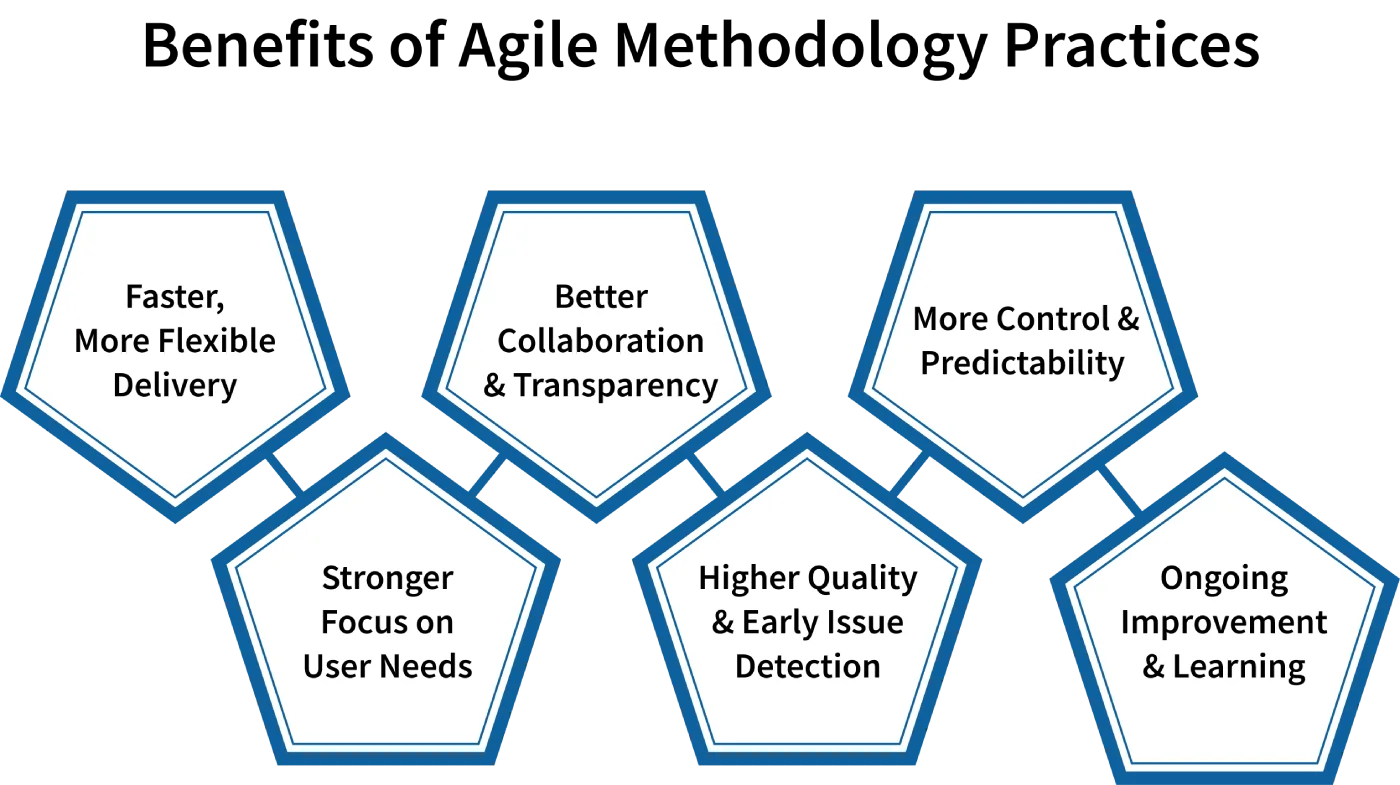
Faster and More Flexible Delivery
Agile model is flexible and therefore the stages of agile appraoch are in constant change. Since the work is performed in small cycles, and priorities may shift, specific deadlines and budgets cannot be provided at the beginning. The agile system process can prove to be cumbersome when you require strict cost approximations or rigid time schedules.
Better Alignment with User Needs
The steps of agile system rely on daily communication and cooperation. Without the standups, backlog refinement or sprint review, the people can slow down the progress and ignore problems. To make agile practises successful, everybody must remain engaged and responsible.
Improved Team Collaboration and Transparency
Agile lets you make changes anytime, which is helpful, but it can get messy if not handled properly. The backlog increases rapidly when the stakeholders often append new requests or change priorities. This may overpower the team, and it may be difficult to concentrate on what is really important.
Higher Quality and Early Problem Detection
Models of the Agile framework require discipline. You keep on refining, testing early and changing plans. When you are unfamiliar with what Agile project methodology is or are not so skilled with technology, you can derail quickly. The team might fail to apply agile principles correctly and end up slowing down instead of speeding up without the right guidance.
Greater Control and Predictability
Agile system considers working features more important than extensive paperwork. Although this accelerates delivery, it may introduce knowledge gaps. Additional staff or subsequent phases of a project might find this difficult since key information was not recorded. In the absence of records, maintenance over the long term may be challenging.
Continuous Improvement and Learning
Agile methods work great when things change often. They don’t work as well when projects have strict rules, many approvals, or fixed plans. The traditional project methods can be more dependable than agile system practices when change is constrained or deadlines are set.
What Are the Limitations of Agile Methodology Models?
Agile is helpful, but it also has some problems that can make planning, teamwork, or certain projects harder for you.
Hard to Predict Timelines and Costs
Agile model is continuously evolving according to the feedback and priorities. That is very flexible until the time that someone demands specific dates and budgets. As the work is done sprint by sprint, it may be hard to provide a definitive schedule in the initial stages. This may prove to be stressful as you are required to meet deadlines or explain costs before the actual work and learning even commences.
Requires Active Team Participation
Open communication is essential in agile system processes such as daily standups, sprint reviews, and planning. When your team is unable to share updates or to raise issues fast, the process will slow down. You would lose track, overlook dangers, or squander energy. The practises of the agile approach can be effective only when all people remain active in discussions and are in charge of the progress.
Can Overwhelm Teams with Frequent Changes
Agile accepts changes at any point, so some stakeholders tend to push new ideas too frequently. The backlog continues increasing, priorities are changing, and the team is overwhelmed. You may lose track of what is important to you. You need to guard the stages of agile system against interminable additions, or the process gets out of control.
Documentation Often Takes a Backseat
Documentation is a low priority when it comes to the rush to create working features. As you add new features or members, details are required later, and you are slowed down because of the absence of information. The use of agile framework process is yet to be properly documented to ensure the long-term work remains maintainable and scalable.
Not Always Suitable for Strictly Regulated Projects
Agile approaches are very effective in software or high-speed products. But agile doesn’t fit well for projects that have strict rules, fixed plans, or too many approval stages. The strong point of agile becomes a weakness when change is not permitted or timelines are set in stone. A classical strategy may be more appropriate.
How BIXO Makes Agile Projects More Effective?
BIXO changes how you manage agile projects by handling all the follow-ups and status checks that usually take up your time. Instead of asking team members for updates, BIXO automatically gathers progress on tasks, keeps track of deadlines, and gives you easy-to-read summaries. You can quickly see which tasks are on track, spot any problems, and spend your time on planning and strategy instead of daily monitoring. Even with 100 team members, BIXO makes managing work simple by keeping everything moving without micromanaging.
BIXO helps your team work better, not just stay updated. It spots problems early, only alerts you when needed, and keeps different teams coordinated so nothing gets stuck. You save time that used to go to standups, follow-ups, and manual tracking, while still seeing progress in real time. By taking care of routine management, BIXO lets you focus on guiding your team, improving work, and getting more done, without hurting work-life balance or team support.
Conclusion
Agile approach helps you manage projects in a flexible and practical way. It breaks big goals into smaller, doable steps and lets you adjust when things change. By working in short cycles, keeping track of progress, and focusing on what’s most important, you can deliver results faster, work better with your team, and improve your plans based on real feedback. Using the right approach and tools, you can stay organised, avoid delays, and make sure every part of the project meets actual needs, all while keeping work clear and productive.
FAQs
Agile methodology helps you handle projects in small steps. You can easily adjust to changes, finish work faster, focus on what users want, and make your team work together better.
Sprints split your work into short periods, usually 2 - 4 weeks. During each period, you plan, do the work, check how it went, and make improvements. This helps you spot problems early, change priorities if needed, and keep delivering useful features steadily, without waiting until the end.
Different Agile types fit different needs. Use Scrum for organized work cycles, Kanban to see tasks visually, Lean for efficiency, XP for technical updates, or Adaptive/Crystal when goals change. Pick what suits your team and project.
Agile means everyone needs to take part, stay flexible, and keep talking with each other. You might deal with changing timelines, frequent updates, and less paperwork at first. Using planning tools and following simple routines keeps work on track without stressing the team.
Get a demo of BIXO
Recommended Blogs
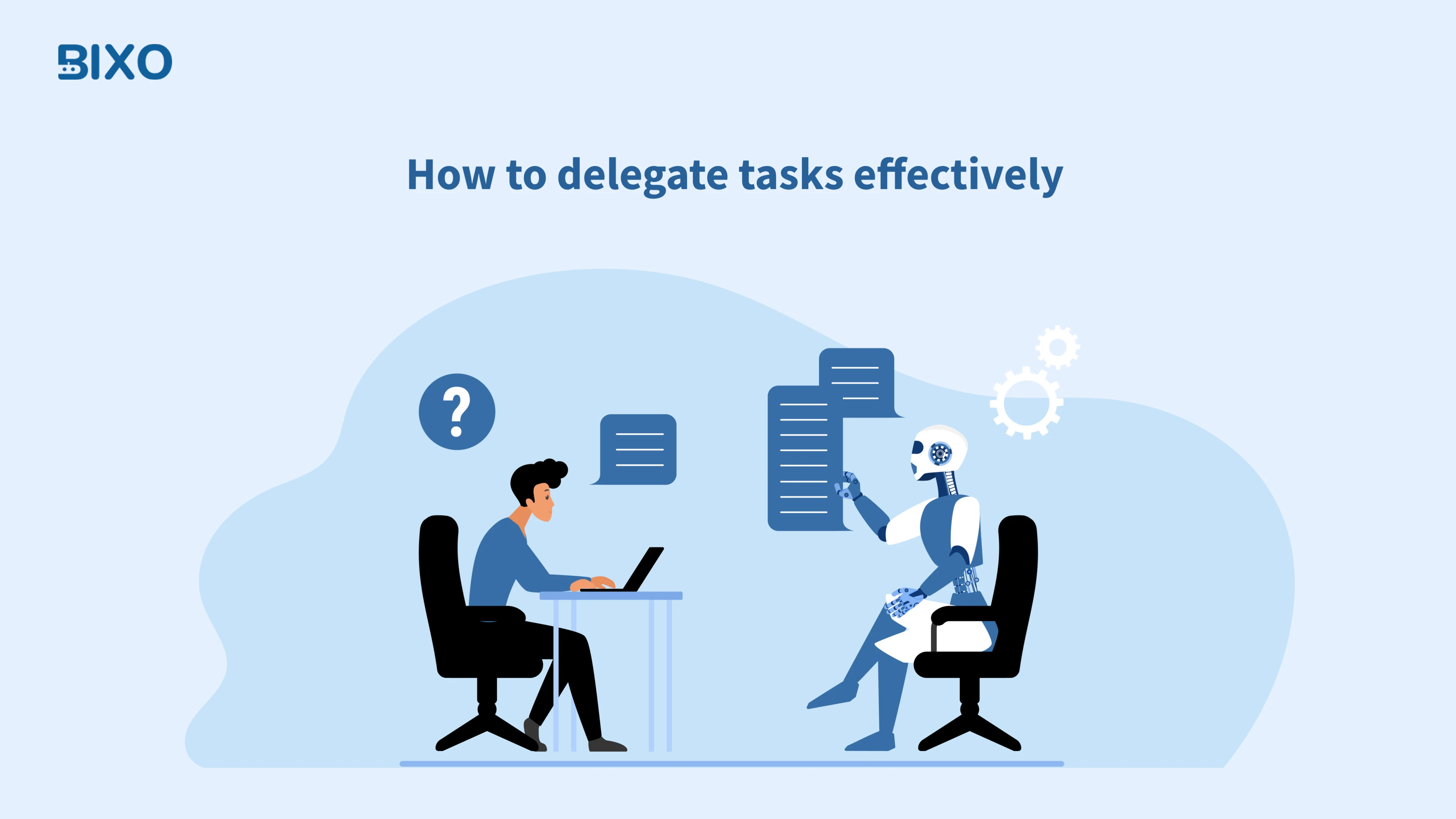
How to Delegate Tasks Effectively: 7 Tips for Managers
Learn how to delegate tasks effectively, save time, and boost team productivity with step-by-step tips, real examples, and smart AI tools.
 Bhuvana Bitra |
Bhuvana Bitra |
 Oct 17, 2025
Oct 17, 2025
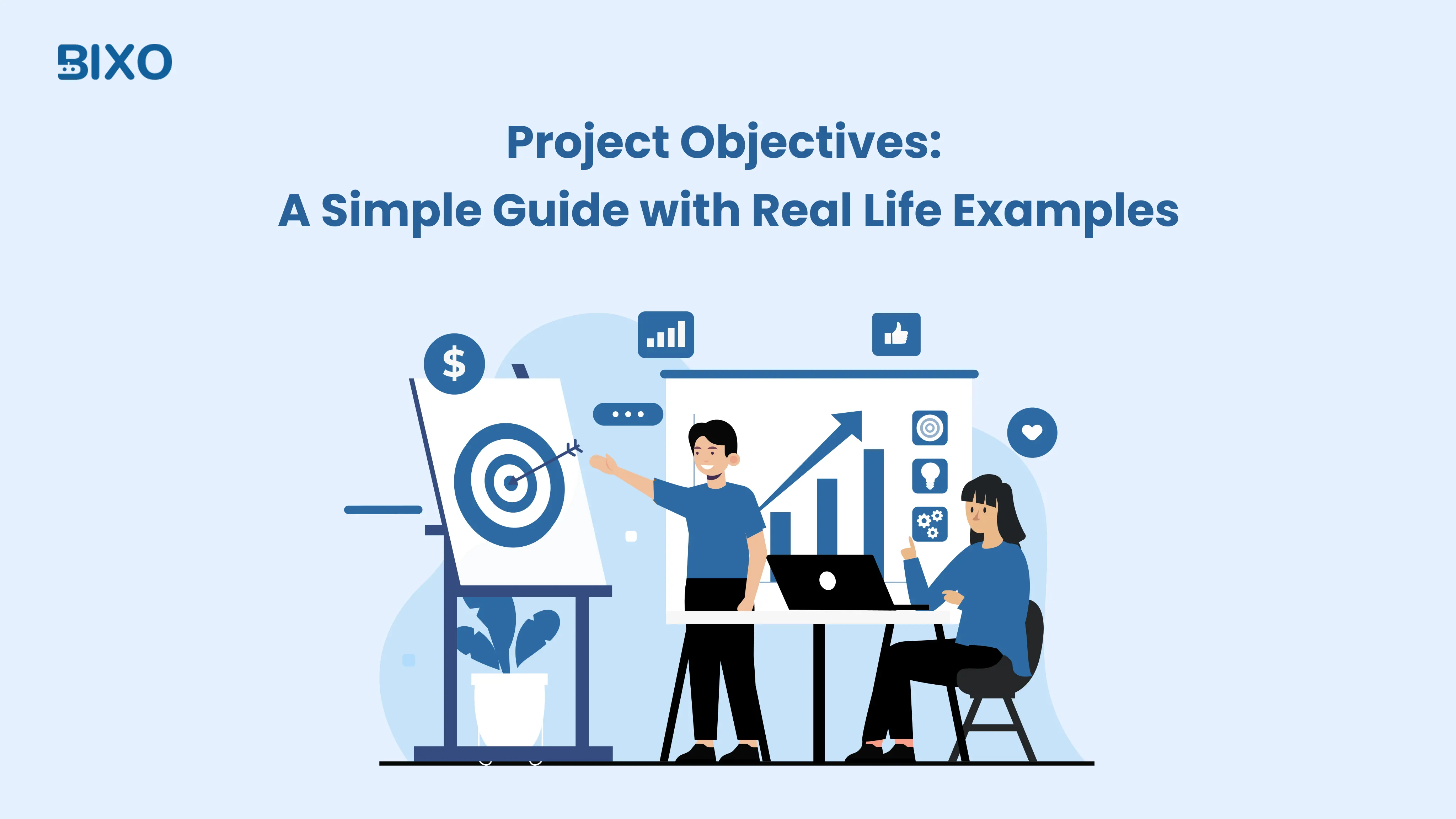
Project Objectives: A Simple Guide with Real Life Examples
Learn how to set clear project objectives that guide your team, track progress, and ensure success. Get practical tips and real-life examples to get started right.
 Tarun Kumar Reddy Atmakuru |
Tarun Kumar Reddy Atmakuru |
 Oct 17, 2025
Oct 17, 2025

25 Key Project Management Skills Every Manager Should Master
Learn 25 essential project management skills - soft, hard, and technical to manage teams, meet deadlines, and deliver successful projects.
 Tarun Kumar Reddy Atmakuru |
Tarun Kumar Reddy Atmakuru |
 Oct 17, 2025
Oct 17, 2025
